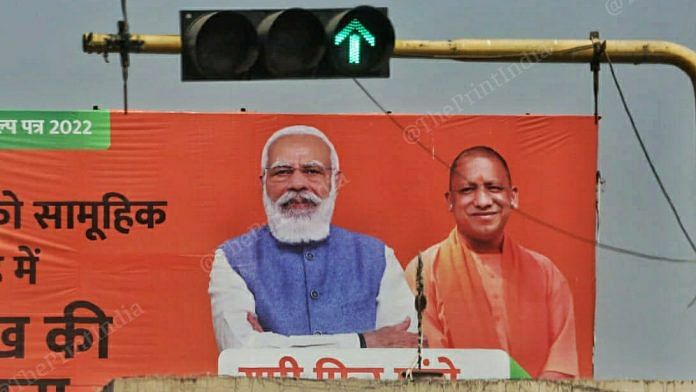An M-Y factor has worked in Uttar Pradesh again, but not of the Muslim-Yadav formula of yore. This time, M-Y meant Modi-Yogi — the double engine of Prime Minister Narendra Modi and chief minister Yogi Adityanath pushing the welfare schemes hard through layers and layers of administration.
‘Vikas’ is no more the Godot that never arrives because in UP, benefits did reach the target and schemes managed to breach walls of corruption. In a state where rules are violated with pride, the chief minister implemented law and order with a heavy hand and the electorate has appreciated it.
The new M-Y
Serendipitously, though, M-Y for Uttar Pradesh in this assembly election also has another powerful meaning — mahila and youth. Both these segments of the electorate, it now appears, came out in big numbers and voted for Modi and Yogi, and they had several reasons for doing so. From providing toilets to housing schemes, gas cylinders to loans, from stopping instant triple talaq to imposing law and order, the Modi government worked to empower women of different strata. Data will reveal that a sizable number of women electorate chose Modi and Yogi despite the fact that the male members of their family voted differently. This is significant, as it would mean that women are no longer taking advice on voting from males, they are making their own decisions keeping their interests in the centre.
Similarly, different sections of youth are convinced that Modi and Yogi have something to offer to them. Be it those studying in the prestigious IITs or the ones aspiring for a simple job as security guards, the youth have realised that the vatavaran or ecosystem for education, employment, entrepreneurship and empowerment in Uttar Pradesh could only exist under the captaincy of Yogi and coach Modi. It appears that regardless of their caste, class, gender and religion, youth have also voted for BJP in large numbers.
M-Y could also be media and yojana where media and social media played a big role in disseminating the message — of work done by Modi and Yogi during the Covid crisis and beyond. People were irked with the government but not hopeless, as they were able to see through media and social media that all efforts were being marshalled to save every life. The schemes (yojana) designed and implemented by the Modi and Yogi government also played a critical role. People realised that schemes are not framed for files and the benefits can actually travel from Delhi and Lucknow and reach them in time of need, unlike the past. Thanks to the gender consciousness in these schemes, there has been a visible change in the daily lives of common women. A new section of beneficiary or labharthi class has emerged which, despite (or even instead of) taking money or liquor on the night before election, thinks of voting for a government that will give them benefits throughout the year. In this sense, the poor class has shown loyalty for BJP once again. Importantly, BJP is no more a middle class, urban, upper-caste party. Today, the silent majority of the country is firmly aligned with the party under Modi.
Also read: Yogi Adityanath — ‘curious boy’ who became firebrand leader makes history with 2nd term as UP CM
The shift in heartland politics
Uttar Pradesh results confirm what many have been saying for a while now. Something bigger has shifted in the heartland politics. Caste and religion no longer hold the winning keys. Factors of urbanisation, globalisation, market economy, social and physical infrastructure need to be taken into consideration as they are deeply influencing and reshaping Indian politics like never before.
Importantly, it seems that now is the time to start thinking about identity politics in horizontal and intersectional terms with issues such as women safety, youth aspirations, welfare schemes and poverty gaining importance along with vertical identities of caste and religion. The repeated victories of the BJP establish Modi as a transformational leader as opposed to the transactional leaders of the past. One, who is shattering the old norms of Indian politics – right, left and centre.
Swadesh Singh teaches Political science in Delhi University. Views are personal.
(Edited by Anurag Chaubey)



